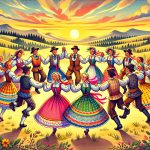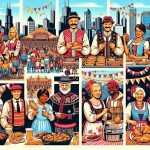
Poland celebrates many holidays and festivals that showcase its rich culture and history. One of the main celebrations is Wielkanoc, or Easter, where people follow unique traditions like Święconka, blessing food baskets.
Then there’s Christmas, known as Boże Narodzenie, which brings families together in a festive spirit.
The country also marks its Independence Day, Narodowe Święto Niepodległości, with a sense of pride, and the harvest festival, Dożynki, highlights the importance of community.
Another special day is Święto Trzech Króli, or Three Kings’ Day. Each of these events plays a significant role in shaping Poland’s identity, showing the depth of its cultural heritage. Let’s dive into these traditions to understand how they contribute to what it means to be Polish.
Wielkanoc: Polish Easter Traditions
Easter in Poland, known as Wielkanoc, is a time filled with unique traditions that showcase the country’s Christian heritage and community spirit. One of the key customs is preparing the Święconka, which are baskets packed with symbolic foods. These baskets get blessed on Holy Saturday in a practice that highlights the importance of faith in Polish daily life. It’s a special moment when people come together, reflecting community bonds and religious devotion.
Another significant tradition is the Rezurekcja, the resurrection mass at dawn on Easter Sunday. This mass is particularly moving as it includes a reenactment of Christ’s resurrection. Attending this service is a powerful experience for many Polish families, reinforcing their faith and the sense of togetherness within the community.
These Easter practices in Poland are more than just rituals. They are a reflection of how deeply Christianity is woven into the fabric of Polish society. They also show how traditions evolve, blending historical customs with modern expressions of faith and community. For example, while the Święconka and Rezurekcja are steeped in history, they are celebrated today in ways that resonate with contemporary Polish families.
In discussing Polish Easter traditions, it’s clear how they offer a glimpse into the country’s cultural soul. They are vivid examples of how faith, tradition, and community can come together in meaningful ways. For those interested in experiencing these traditions firsthand, visiting Poland during Easter or participating in local Polish community events can provide a rich cultural experience. Additionally, exploring books or online resources on Polish Easter customs can offer deeper insights into their significance and how they contribute to Poland’s cultural identity.
Boże Narodzenie: Christmas in Poland
In Poland, the celebration of Christmas, known as Boże Narodzenie, brings families and communities together through time-honored traditions. These practices highlight the country’s rich cultural and religious heritage, ensuring a festive atmosphere filled with warmth and unity. One of the central customs is the Wigilia feast on Christmas Eve. This special dinner is more than just a meal; it is a moment of collective anticipation and bonding. During Wigilia, families share opłatek, a thin wafer, symbolizing wishes for health and happiness in the coming year.
The feast includes twelve dishes, none of which contain meat, showcasing Poland’s diverse culinary traditions. This choice reflects the country’s Christian heritage, specifically the practice of fasting before Christmas Day. Notably, one of these dishes often includes fish, such as carp, prepared in various ways, from fried to jellied forms.
Another significant tradition is setting an extra place at the table. This gesture is a powerful demonstration of hospitality and remembrance, symbolizing an open door for any unexpected guest or in memory of loved ones who are no longer present. It’s a poignant reminder of the importance of community and remembering those we miss during the holiday season.
These customs do more than just bring families together; they are a time for reflection, gratitude, and hope. They connect the present with the past, ensuring that the values and traditions of previous generations are remembered and passed on. Celebrating Boże Narodzenie in Poland is about reinforcing family ties and a shared sense of identity, making it a deeply meaningful time for many.
In conversations about Christmas in Poland, it’s clear that the holiday goes beyond mere celebration. It’s an integral part of the national identity, marked by unique and heartfelt practices that reflect a collective spirit of generosity, reflection, and joy. Whether it’s through the sharing of opłatek, the preparation of special dishes, or the setting of an extra place at the table, these traditions are cherished components of the Polish Christmas, bringing to life the values that have shaped the nation’s culture and heritage.
Narodowe Święto Niepodległości: Independence Day
Independence Day in Poland, celebrated on November 11th, is a significant national holiday. It commemorates Poland regaining its independence in 1918 after being partitioned by foreign powers for 123 years. This day is more than just a date on the calendar; it’s a celebration of Polish culture, identity, and the resilience of its people. It’s a time when Poles come together to honor their history and the heroes who fought for their freedom.
The day is marked by various activities across the country. You’ll find military parades showcasing Poland’s defense forces, patriotic events that stir national pride, and ceremonies where people lay wreaths at monuments of national heroes. These activities are not just formalities; they’re heartfelt expressions of gratitude for the sacrifices made for Poland’s independence.
One of the key aspects of Independence Day is its role in educating and reminding the younger generations about their country’s past struggles and victories. It’s a day that prompts discussions about what it means to be Polish and the importance of preserving one’s national identity and sovereignty.
Moreover, Independence Day serves as a catalyst for unity. It brings people together, not just in celebration, but in a shared reflection on their nation’s journey. It’s a powerful reminder that despite past adversities, Poland has forged its own path and continues to thrive.
Dożynki: Harvest Festival Celebrations
Dożynki is the Polish Harvest Festival, celebrating the completion of the agricultural season. This festival, with its roots in ancient pagan practices, has become an essential part of the Polish calendar, expressing gratitude for the harvest. The highlight of the festival is a parade featuring a wreath made from the season’s last sheaf of grain. This wreath, which represents the harvest spirit, gets a blessing in a church, showing how old traditions blend with Christian faith in Poland.
During the festival, people enjoy folk music, dance, and share food. These activities strengthen community ties and help keep Poland’s rural culture alive. For example, traditional dishes often shared during Dożynki include pierogi and bigos, providing a taste of Poland’s culinary heritage. Additionally, folk bands playing traditional tunes with instruments like the accordion and violin add to the festive atmosphere, making the event a vibrant celebration of Poland’s agricultural achievements and cultural traditions.
Święto Trzech Króli: Three Kings’ Day
Three Kings’ Day, celebrated on January 6th in Poland, is a major holiday known as Święto Trzech Króli. It commemorates the journey of the Magi, also known as the Three Wise Men or Kings, who followed a star to visit the newborn Jesus. This event is significant because it shows the moment when Jesus was revealed to the world, not just to the Jewish people. In Poland, this day is not just about religion; it’s a time when the whole community comes together to celebrate.
One of the most exciting parts of Three Kings’ Day in Poland are the parades. People dress up as the three kings, which brings a sense of excitement and festivity to the streets. These parades aren’t just for show; they symbolize the journey of the Magi and the universal message of Christianity. It’s a vivid reminder of the story behind the holiday and makes it more relatable to everyone, regardless of their background.
Another unique tradition is the blessing of chalk and the inscribing of the initials of the three kings (C+M+B) above doorways. This practice is believed to bring good luck and protection to the house and its inhabitants for the coming year. It’s a simple yet profound way of marking the occasion, blending spiritual beliefs with everyday life.
Three Kings’ Day in Poland is more than a religious observance; it’s a cultural event that fosters community spirit and national identity. It connects people to their faith and to each other, making it a key date in Poland’s festive calendar. This holiday serves as a reminder of the importance of tradition, unity, and the shared values that tie a community together.
Conclusion
Poland has a rich collection of holidays and festivals that really show what the country is all about. From celebrating Easter (Wielkanoc) and Christmas (Boże Narodzenie), which reflect the country’s strong Catholic beliefs, to showing national pride on Independence Day (Narodowe Święto Niepodległości), and honoring farming traditions during the Harvest Festival (Dożynki), these events are a big deal in Poland.
The Three Kings’ Day (Święto Trzech Króli) is another important day that mixes religious celebration with cultural identity, showing how diverse Polish festivities can be. All these special days bring people together, highlighting the importance of tradition, faith, and pride in being Polish. They’re a clear sign of Poland’s rich cultural heritage and the values that matter to its society.






Comments are closed.